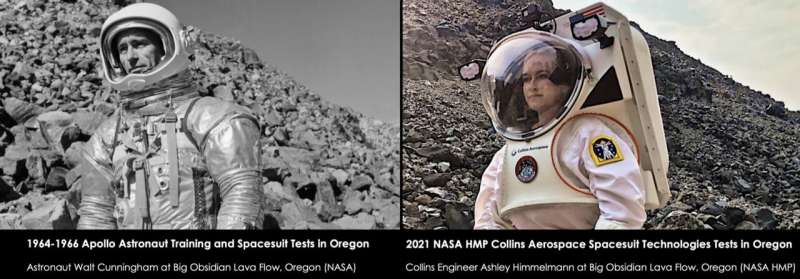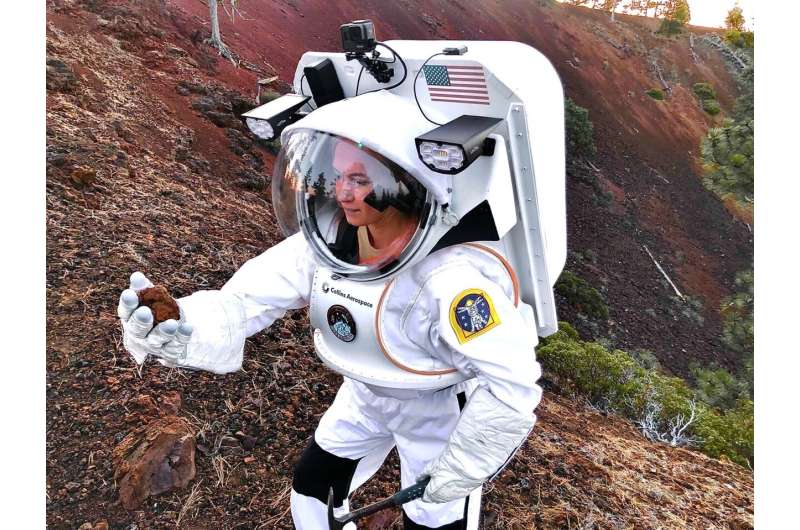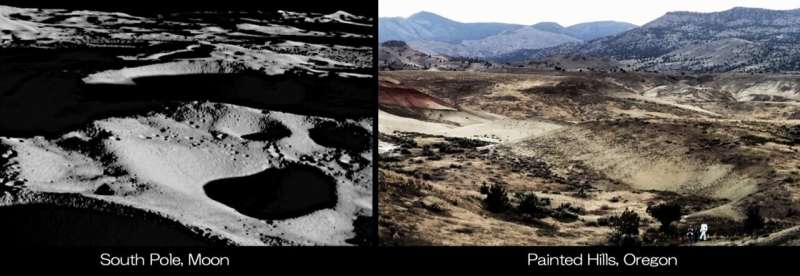New spacesuit engineering for moon and Mars exploration examined the place Apollo astronauts after qualified and tested spacesuits
6 min read
The NASA Haughton-Mars Task (HMP) and collaborating companies SETI Institute, Mars Institute, Collins Aerospace, and Ntention are saying the successful area testing of new spacesuit technologies for foreseeable future astronaut science and exploration operations on the Moon and Mars.
The industry checks were conducted in Oregon’s High Desert location, at the very same web pages when applied by Apollo astronauts to practice and test spacesuits in preparing for their historic journeys to the Moon. Numerous new web pages also regarded relevant for future Moon and Mars exploration in hindsight of the classes from Apollo and from new robotic missions to the Moon and Mars, were also visited.
“It was fascinating to be in Oregon to revisit some of the quite locations the place, in 1964 and 1966, the Apollo astronauts obtained area teaching in geology and analyzed spacesuits,” explained Dr. Pascal Lee, a planetary scientist with the SETI Institute and the Mars Institute, and director of the NASA Haughton-Mars Task at NASA Ames Analysis Heart. “We have also discovered new applicant sites for Moon and Mars exploration preparation, now that we know a lot more, compared to the mid-60s, about the Moon and Mars.”
The websites visited by the NASA Haughton-Mars Job staff bundled the primary Apollo legacy teaching and spacesuit check web pages in Oregon: Lava Butte, Big Obsidian Lava Move, Fort Rock, Hole in the Floor, and Yapoah Lava Movement at McKenzie Go. New web-sites frequented in preparing for checking out the Moon’s south polar highlands and lunar caves, and at some point Mars, included Pumice Slope at Crater Lake National Park, the Painted Hills at John Day Fossil Beds Nationwide Monument, and Skylight Cave, a lava tube with numerous roof collapse openings. The sites were being accessed with aid from the United States Forestry Services Deschutes Nationwide Forest and the National Park Company.

NASA’s current Artemis Software aims to land the first lady and up coming gentleman on the Moon, around the lunar South Pole, by the conclude of this decade and build on this experience to at some point send out humans to Mars. In anticipation of the science and exploration wants of future Moon and Mars astronauts, several new systems are going through enhancement and screening to help enhance the security, productivity, and value-success of potential EVAs (Additional-Vehicular Routines) or spacewalks.
Central to the week’s subject exams was Collins Aerospace’s progressive, built-in Information Technologies and Informatics Subsystem (IT IS). Presently, astronauts on spacewalks depend on spiral-bound notebooks hooked up to their elbows to flip by way of checklists. The Collins IT IS makes it possible for astronauts to autonomously track these checklists and act on the status of their overall health and that of their EVA companions (essential signals, exertion levels) as a result of a display procedure in their helmets. They can also monitor the general performance of a extensive variety of EVA systems—power, oxygen, h2o reserves—the astronauts’ spot, EVA elapsed time, EVA time remaining, and vary from materials. The IT IS also shows maps and a broad array of other details supporting astronaut science and exploration things to do, this sort of as imaging, take note-using, and sample administration.
“We see the integration of our Information Technologies and Informatics Subsystem into a spacesuit as a match-changer for conducting EVAs,” suggests Greg Quinn, direct for state-of-the-art spacesuit enhancement at Collins Aerospace. “The Collins IT IS will aid increase the autonomy, productiveness, and safety of foreseeable future explorers.”
“When actual-time mission support from Earth will remain critical, checking out the lunar poles, where NASA intends to land Artemis astronauts, indicates that direct-to-earth communications will not, at periods, be attainable, even through orbital relays. So we want to provide foreseeable future lunar explorers with the signifies to safely and securely execute much more autonomous EVAs,” clarifies Lee. “The want for autonomy will be even more compounded in the circumstance of Mars, in which communications delays will greatly limit genuine-time mission aid from Earth.”

Subject checks in Oregon commenced at dawn several hours every early morning to acquire gain of grazing solar illumination in anticipation of hard lighting ailments at the lunar South Pole. The discipline websites accessed presented a extensive vary of terrain roughness, slopes, topographic complexity, and scales of operation predicted through long term EVAs in the lunar South Pole region. EVA techniques necessities for upcoming lunar pit and cave exploration had been also investigated, a first for a spacesuit manufacturer.
One particular of the industry campaign’s critical achievements was properly integrating the Norwegian business Ntention’s revolutionary Astronaut Good Glove (ASG) method with Collins Aerospace’s IT IS. The ASG is an sophisticated human-machine interface (HMI) integrated into the spacesuit helmet and glove. It will allow an astronaut to remotely run a large array of doable robotic property these kinds of as robotic arms, cranes, rovers, and even drones, with minimal hand gestures appropriate with donning a constricting and rigid pressurized spacesuit. The ASG subject test demonstrated the prosperous assortment of rock sample elements from distant destinations not instantly obtainable to the astronaut.
“Our discipline exam this 12 months shown how an HMI like our Astronaut Intelligent Glove process can be seamlessly integrated into a spacesuit and supply long term astronauts on the Moon and Mars considerably bigger notion, arrive at, and command of their environment,” claimed Moina Tamuly, Co-CEO and Co-Founder of Ntention.
“By coming to Oregon, we required to recapture Apollo’s historic legacy, but also scout out new experiences for foreseeable future astronaut teaching and spacesuit testing as we get on this century’s new problems, the lunar poles and Mars,” said Lee. “I’m psyched to report that we did capture a glimpse of this interesting long term this 7 days.”
An astronaut good glove to take a look at the moon, Mars and beyond
For more information on the HMP, go to https://www.nasa.gov/analogs/hmp, https://www.marsinstitute.no/hmp
Quotation:
New spacesuit technologies for moon and Mars exploration examined wherever Apollo astronauts at the time experienced and analyzed spacesuits (2021, September 9)
retrieved 11 September 2021
from https://phys.org/news/2021-09-spacesuit-technologies-moon-mars-exploration.html
This document is subject matter to copyright. Apart from any truthful working for the reason of personal examine or investigate, no
portion may be reproduced with out the penned permission. The written content is furnished for information and facts purposes only.







